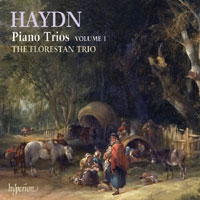
Wonderfully Auspicious
Haydn from
the Florestan Trio,
reviewed by
ROBERT ANDERSON
Hyperion CDA67719
|

|
In this first volume of the Haydn trios the Florestan team (one hopes their experience has been less traumatic than that of Beethoven's hero) has started towards the end of Haydn's more than thirty contributions to the genre. London was the inspiration for the four works, or rather two of London's more enchanting female inhabitants, Rebecca Schroeter and Therese Jansen. The first three trios were Rebecca's, the last Therese's, who happened also to be a star pupil of Muzio Clementi's.
For many years I possessed a Beck square piano of 1777 and a Stodart grand of 1799; so I could play these trios in modest domestic manner or as if a man of considerable financial means (I hasten to say that both instruments had been a gift). Much sympathy has been expended on the cellist's part in these trios, tied as it mostly is to the pianist's left hand. Sometimes my cellist was Jacqueline du Pré, and never was there a squeak of complaint frrom the finest player of the day. So I recommend special attention to Richard Lester, whose sensitivity down below is wholly admirable.
In all four works Haydn is on top form, dynamic, surprising, and urbane. The stops and starts in the first movement of the D major trio keep one constantly on the alert.
Listen -- Haydn: Allegro (H XV:24)
(track 1, 0:03-1:55) © 2009 Hyperion Records Ltd
The most famous of the twelve movements is the 'Gypsy' finale to the G major trio. Here the fine team has an authentic flexibility of tempo to emphasise the rich variety of Haydn's invention.
Listen -- Haydn: Rondo all' Ongarese (H XV:25)
(track 6, 0:56-1:56) © 2009 Hyperion Records Ltd
Even the horse and donkeys of the enchanting cover picture by William Shayer seem to be paying careful attention.
Perhaps the least surprising movement is the Adagio cantabile of the F sharp minor trio, which turns out to be identical with the slow movement of Symphony No 102. It would take the prescience of a gypsy to know which of its incarnations was the original. It seems thoroughly at home in this its chamber version.
Listen -- Haydn: Adagio cantabile (H XV:26)
(track 8, 1:14-2:01) © 2009 Hyperion Records Ltd
Therese's opening Allegro needs everything a Stodart grand could give it.
Listen -- Haydn: Allegro (H XV:27)
(track 10, 0:00-2:02) © 2009 Hyperion Records Ltd
Indeed the Florestan players, sensitive to their finger ends, have done more than justice to all four works, and provided a wonderfully auspicious start to their complete Haydn venture.
Copyright © 31 March 2009
Robert Anderson, Cairo, Egypt
 CD INFORMATION: HAYDN PIANO TRIOS VOLUME 1
CD INFORMATION: HAYDN PIANO TRIOS VOLUME 1
Record Box is Music & Vision's
regular series of shorter CD reviews
| 
